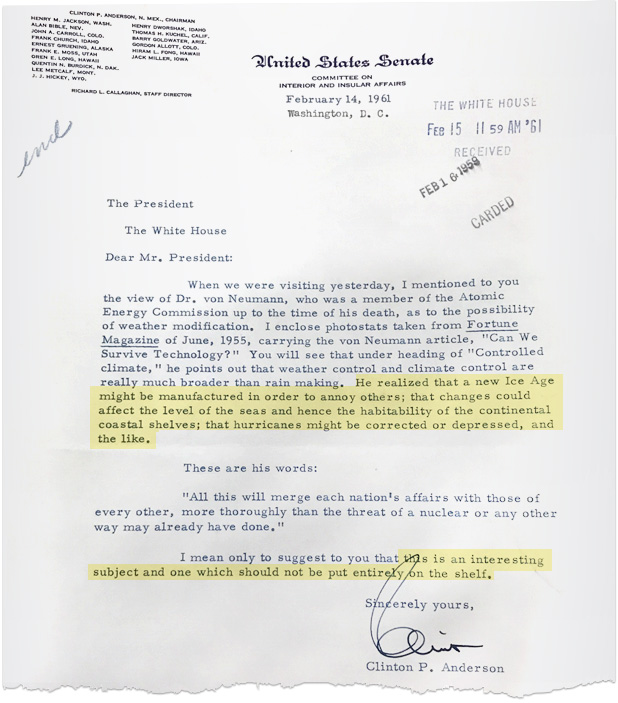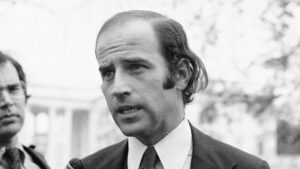Records of the United States government publicly debating, analyzing, or even considering policy prescriptions related to global warming and climate change go back to at least the 1950s. As these debates were happening, the federal government has encouraged and often demanded increased production from energy companies.
A study funded by the Office of Naval Research found that “[t]he extra carbon dioxide released into the atmosphere by industrial processes and other human activities may have caused the temperature rise during the present century.”
Learn More1956President John F. Kennedy met with and exchanged letters with Senator Clinton Anderson (D-NM) about the dangers of a “new ice age” that could “affect the level of the seas and hence the habitability of the continental coastal shelves.”


President Lyndon B. Johnson’s Science Advisory Committee reported that “[b]y the year 2000 the increase in atmospheric carbon dioxide will be close to 25%. This may be sufficient to produce measurable and perhaps marked changes in climate, and will almost certainly cause significant changes in the temperature and other properties of the stratosphere.”
1965President Johnson told Congress that his generation had “altered the composition of the atmosphere on a global scale” in part from “a steady increase in carbon dioxide from the burning of fossil fuels.”
1965President Nixon’s administration recognized the potential impacts of climate change, even as it worked to increase oil and gas production from federal lands.
The White House, Memorandum from Daniel P. Moynihan for John Ehrlichman (Sept. 17, 1969).
1969The U.S. Supreme Court found that the federal government began devoting serious attention to climate change policy in the “late 1970’s.”
Massachusetts v. E.P.A., 549 U.S. 497, 507 (2007).
1970NOAA held a “Workshop on The Global Effects of Carbon Dioxide from Fossil Fuels” attended by 75 scientists who discussed the current knowledge of the carbon dioxide cycle and the consequences of increases in carbon dioxide content.
1977A report requested by the Director of the Office of Science and Technology Policy concluded that “[w]e now have incontrovertible evidence that the atmosphere is indeed changing and that we ourselves contribute to that change. Atmospheric concentrations of carbon dioxide are steadily increasing, and these changes are linked with man’s use of fossil fuels and exploitation of the land.”
1979The U.S. State Department and the President’s Council on Environmental Quality jointly released the Global 2000 Report to the President, which stated that an “environmental problem related to the combustion of fossil fuels (and perhaps also to the global loss of forests and soil humus) is the increasing concentration of carbon dioxide in the earth’s atmosphere.
Gerald Barney, The Global 2000 Report to the President 36 (1980).
1980The Congressional Subcommittee on International Economics held a hearing to discuss the Global 2000 Report to the President’s findings.
1981In a congressional subcommittee hearing, N. Douglas Pewitt, the Acting Director of Energy Research for the Department of Energy, discussed the Department’s research agenda and current challenges of fully understanding the potential impacts of CO2 accumulation on the climate.
1982An EPA report titled Can We Delay a Greenhouse Warming? found that “[e]vidence continues to accumulate that increases in atmospheric carbon dioxide (CO₂) and other ‘greenhouse’ gases will substantially raise global temperature.
1983A report from the Carbon Dioxide Assessment Committee concluded that the “increase [in atmospheric carbon dioxide] is primarily attributable to burning of coal, oil, and gas.”
1983The Senate subcommittee on Toxic Substances and Environmental Oversight held a hearing on the issue of the greenhouse effect and climate change.
1985
The Environmental Pollution Subcommittee hearings specifically concerning climate change, Chairman John H. Chafee emphasized the need to prevent climate change.
See Philip Shabecoff, Aide Sees Need to Head Off Global Warming, N.Y. Times, June 12, 1986, at B8.
1986
Then-Senator Joe Biden introduced the Global Climate Protection Act of 1987.
Global Climate Protection Act of 1987, Pub. L. No. 100-204, 101 Stat. 1331, 1407–09 (1987).
1987
James Hansen of NASA testified before the Senate that “[g]lobal warming is now large enough that we can ascribe with a high degree of confidence a cause and effect relationship to the greenhouse effect.”
1988The Global Warming Prevention Act of 1988 was proposed as a bill in the House.
H.R. 5460: Global Warming Prevention Act of 1988, 100th Cong. (1988)
1988Congress introduced the Global Warming Prevention Act of 1989, that never made it to the House floor.
[H.R. 1078: Global Warming Prevention Act of 1989, 101st Cong. (1989).]
1989The EPA released a multi-volume report, The Potential Effects of Global Climate Change on the United States: Report to Congress.
Congress extended its funding and support for climate research programs by passing the Global Change Research Act of 1990.
S.B. 169, Global Change Research Act of 1990, Pub. L. No. 101-606, 104 Stat. 3096.
1990An EPA report to Congress titled Policy Options for Stabilizing Global Climate noted that “[a]lthough the specific rate and magnitude of future climate change are hard to predict, in the absence of policy responses the observed trends and projected increases in the atmospheric concentrations of greenhouse gases are likely to significantly alter the global climate during the next century.”
1990A report to the U.S. Navy: “Two of the principle effects of climate change - sea level rise and thermal heating of the oceans and atmosphere - present the possibility of significant effects on the facilities, infrastructures and operations of the Navy.”
1991The EPA and the State Department issued a report to Congress, U.S. Efforts to Address Global Climate Change, that addressed “[t]he current international scientific understanding and potential impacts of climate change and potential response strategies.”
1991The Energy Policy Act of 1992 passed into law. It called for investigation into “the feasibility of reducing the generation of greenhouse gases” and the “stabilization and eventual reduction in the generation of greenhouse gases.”
H.R. 776: Energy Policy Act of 1992, 102nd Cong. (1992).
1992The 1993 White House National Security Report said that, “[d]eforestation, climate change, air and water pollution, and depletion of water supplies have far-reaching effects on the capacity of countries to sustain economic growth and ensure a healthy environment for their citizens. . . . Some problems, such as ozone depletion and climate change, can have a global impact.”
The White House, The National Security Strategy of the United States, 11–12 (1993).
1993On Earth Day, 1993, President Bill Clinton committed the United States “to reducing our emissions of greenhouse gases to their 1990 levels by the year 2000.” Clinton stated: “We also must take the lead in addressing the challenge of global warming that could make our planet and its climate less hospitable and more hostile to human life.”
1993A White House National Security Report mentioned that “[t]he President developed a Climate Change Action Plan to help reduce greenhouse emissions at home and launched the U.S. Initiative on Joint Implementation to help reduce emissions abroad.”
1996The EPA’s website included a page discussing climate change, noting “[t]he earth’s climate is predicted to change because human activities are altering the chemical composition of the atmosphere through the buildup of greenhouse gases—primarily carbon dioxide, methane, and nitrous oxide. The heat-trapping property of these gases is undisputed. Although uncertainty exists about exactly how earth’s climate responds to these gases, global temperatures are rising.”
Environmental Protection Agency, The Climate System, EPA.gov.
1997The EPA’s website included a page discussing climate change, noting “[t]he earth’s climate is predicted to change because human activities are altering the chemical composition of the atmosphere through the buildup of greenhouse gases—primarily carbon dioxide, methane, and nitrous oxide. The heat-trapping property of these gases is undisputed. Although uncertainty exists about exactly how earth’s climate responds to these gases, global temperatures are rising.”
Environmental Protection Agency, The Climate System, EPA.gov.
1997In a United Nations Framework Convention on Climate Change (“UNFCCC”) meeting (which took place in Kyoto, Japan), the Kyoto Protocol was adopted.
[UNFCCC, What is the Kyoto Protocol?, United Nations Climate Change.]
1997The U.S. Senate unanimously passed (95-0) the Byrd-Hagel Resolution, which stated that the United States should not be a signatory to any UNFCCC agreement that did not mandate “new specific scheduled commitments to limit or reduce greenhouse gas emissions for Developing Country Parties.”
S. Res. 98, 105th Cong. (1997–1998).
1997
Dr. Janet Yellen testified before the Senate Committee on Agriculture, Nutrition, and Forestry on the economics of the Kyoto Protocol.
1998The EPA issued a report titled “Climate Change And Hawaii” that described the threat of climate change to Hawai‘i’s ecosystem, agriculture, water resources, coastal areas (including sea level rise), and resident heath.
Environmental Protection Agency, Climate Change Hawaii (1998).
1998The National Energy Policy Development Group, which was established in 2001 by the President Bush.
2001A resolution called for Congress to acknowledge that “the United States should develop, promote, and implement, at the earliest possible time, policies to reduce domestic emissions of fossil fuel generated carbon dioxide and other greenhouse gases,” and specifically referenced that the IPCC “has found that most of the observed warming over the last fifty years is attributable to human activities, including fossil-fuel generated carbon dioxide emissions.”
2001The National Greenhouse Gas Emissions Inventory Act was proposed to “amend the Clean Air Act to establish an inventory, registry, and information system of United States greenhouse gas emissions to inform the public and private sectors concerning, and encourage voluntary reductions in, greenhouse gas emissions.”
National Greenhouse Gas Emissions Inventory Act of 2002, H.R. 4611 107th Cong. (2002).
2002The Climate Stewardship Act of 2003 proposed to limit the amount of greenhouse gas emissions from the electricity generation, transportation, industrial, and commercial economic sectors to 2000 levels.
Climate Stewardship Act of 2003, S. 139, 108th Cong. (2003).
2003The Safe Climate Act of 2007 was proposed in Congress to direct the EPA to set “targets for a 2% reduction in greenhouse gas emissions each year from 2010-2050.
Safe Climate Act of 2007, H.R. 1590, 110th Cong. (2007).
2007The Quadrennial Defense Review Report of 2010 contained a section on Crafting a Strategic Approach to Climate and Energy.
U.S. Department of Defense, Quadrennial Defense Review Report, 84 (Feb. 2010).
2010The “Climate Change – Science” page of EPA’s website indicated: “As with any field of scientific study, there are uncertainties associated with the science of climate change.”
Environmental Protection Agency, Climate Change – Science, EPA.GOV.
2010Under the Obama administration, the United States agreed to the Paris Agreement, which aimed to limit global temperature increase to 1.5 to 2℃ above preindustrial levels.
UNFCCC, The Paris Agreement, United Nations Climate Change.
2015During the presidential campaign, Donald Trump promised to “cancel” the Paris Agreement if elected.
2016The Trump administration formally notified the United Nations of its intention to withdraw from the agreement.
Paris Climate Accords: US Notifies UN of Intention to Withdraw, BBC News (Nov. 5, 2019).
2019The federal government had funded the study of climate change since the 1950s, when the U.S. Weather Bureau managed federal funding for climate research as part of its program focused on “inadvertent climate modification.”
1950sBy the mid-1960s, “a variety of government agencies together spent roughly $50 million a year for all aspects of meteorological research,” which included a “few percent” for climate change studies.
1960sFederal spending on climate change grew rapidly in the 1970s. The budget for the “global monitoring of climate change,” which included research into the greenhouse effect, increased by 400% between 1971 and 1975.
[Weart, supra note 188, at 443]
1970sThe passage of the 1978 National Climate Program Act included a $50 million annual budget for climate-related research projects.
1978Funding for climate research had transitioned from meteorology into a well-funded initiative of the U.S. Department of Energy under its “Carbon Dioxide Research and Assessment Program.”
1970sFederal funding for climate science research increased under the Reagan administration (1981–1989).
1980sReagan “proposed $190.5 million for 1990 research on global warming and depletion of Earth’s ozone layer – up more than 30% from this year [1989].”
1989The U.S. Global Change Research Program (“USGCRP”) was created to coordinate interagency research into global climate change.
1990Under the George H. W. Bush administration, the USGCRP consistently received an annual budget of over $1.5 billion.
1989 – 1993President Clinton’s Climate Change Action Plan included $1.9 billion in new and redirected federal funding from 1994 to 2000 and promised to leverage over $60 billion in private investment for environmental technologies.
[Sharon Tisher, A Climate Chronology 35 (2020)]
1994 – 2000President Bush (2001–2009) proposed “to provide the National Aeronautics and Space Administration (NASA) with $120 million over three years to upgrade its ability to carry out state-of-the-art climate change research.”
2001